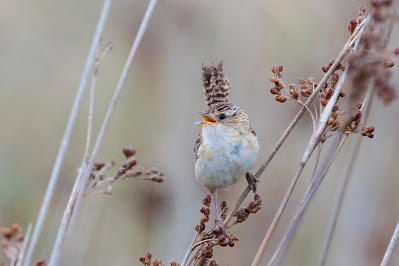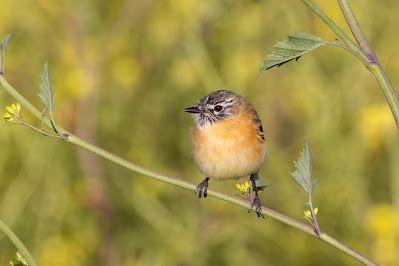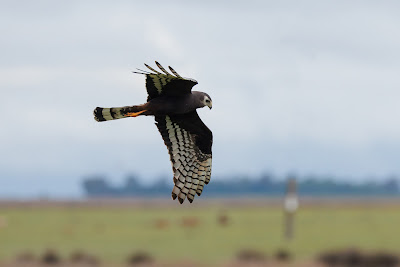Argentina: Pampas to Patagonia (Part 2: San Clemente)
Oct 25
Our direct redeye from JFK to Buenos Aires landed mid-morning. We passed through immigration, collected our bags and picked up our one-way rental car, a Fiat Cronos, without much trouble. Dave & Dave apparently missed the "pack light" memo, but we were able to squeeze all of our gear into that little sedan! It was hard to believe a vehicle that size would take us from Buenos Aires all the way to northern Patagonia, but we trusted our research that the main roads in that part of Argentina would be passable in a sedan.
The plan was to head directly to the coastal community of San Clemente del Tuyu, a four hour drive, after picking up supplies for the road. On our way out of town we encountered our first roadside SOUTHERN SCREAMERS and HARRIS'S HAWK. CHIMANGO CARACARAS whipped overhead, a sign of things to come, as they would remain a constant throughout the trip, all the way to the tip of the continent.
Further along, in the pampas now, we picked up GREATER RHEA and our first LONG-WINGED HARRIER, which proved to be reasonably common on this first leg of the trip. The dark morphs of this species are particularly striking.
 |
| Long-winged Harrier |
Further southeast along Route 2 we started to see pools of water. It had been a looong night/day, and we were aiming for a reasonable arrival time at our accommodations in San Clem, but we couldn't help but pull over a few times to scan. It's a good thing we checked out the gulls, because among the dozens of BROWN-HOODEDS we had our only decent looks at GRAY-HOODED GULLS of the trip. Our final roadside pond delivered 44 BLACK-HEADED DUCKS, a species we thought we might have to work for.
While cutting eastward on Route 63, Tripp spotted a WHITE-BROWED MEADOWLARK while we were blowing by at ludicrous speed. Turning around as quickly as we could, the bird remained in position for nice views from the car! Meanwhile, two MAGUARI STORKS flew across the road. For not having reached our first "birding spot," we were doing alright!
 |
| White-browed Meadowlark |
Around 6pm we finally reached Canal #2, a productive freshwater wetland en route to the coast. Now less than a half hour from town, we decided to bird the place until dusk. Over that 90 minutes we tallied a quick 55 species including PLUMBEOUS RAIL, BARE-FACED IBIS, WREN-LIKE RUSHBIRD, MANY-COLORED RUSH-TYRANT (wow), WARBLING DORADITO, many SPECTACLED TYRANT, BROWN-AND-YELLOW MARSHBIRD, and BLACK-AND-RUFOUS WARBLING FINCH. Since none of us had previously been to this part of South America, lifers abound.
 |
| Black-and-rufous Warbling Finch |
 |
| Warbling Doradito |
 |
| Rufous-collared Sparrow |
On our way out, as dark was falling, we spotted a melanistic GEOFFROY'S CAT stalking through the reeds - total surprise and early candidate for mammal of the trip.
 |
| Geoffroy's Cat |
After check-in at Hotel VIP and a sit-down dinner, despite being completely knackered, we headed to a nearby town park where two STRIPED OWLS were found calling. One bird cooperatively perched low and in the open for stellar spot-lit views of this locally scarce species.
We crashed hard that first night, but not for long. This was something we would have to get used to given our ambitious itinerary!
Oct 26
Up and out at Punta Rasa in hopes of turning up a Dot-winged Crake in the marshes there. We were greeted by a cool, raw wind from the northeast in advance of a storm that was due to deliver a whole lot of wind and rain. If the crakes were there, they were not digging the weather any more than we were.
There were many other targets here, and we saw just about all of them. On our way out the sandy road, between attempts at the crake, we connected with several key passerines such as FRECKLE-BREASTED THORNBIRD, SULPHUR-BEARDED REEDHAUNTER, BAY-CAPPED WREN-SPINETAIL, GRASS WREN, LONG-TAILED REED FINCH, and GREAT PAMPA-FINCH.
 |
| Great Pampa-Finch |
 |
| Grass Wren |
 |
| Tripp |
The mudflats and beach held quite a few shorebirds, too. We took particular pleasure in seeing several AMERICAN GOLDEN-PLOVER and HUDSONIAN GODWIT. Both species are scarce in our neck of the woods back home, especially the godwit.
The focus of the beach, however, was the gull and tern show. This is a reliable location to see the range-restricted OLROG'S GULL, which we found with ease. We tallied 91 individuals, though all were ratty immatures. Presumably the adults were further south, closer to the breeding grounds.
 |
| immature Olrog's Gulls in flight |
The wind had really picked up by this point. Sand was blowing and our scopes had no chance of staying upright. The water's edge was littered with hundreds of terns of six species. COMMON TERNS were particularly abundant, numbering ~1,200. The birds were not terribly approachable, but we carefully crept as close as we could. The star of the show here, and one of my favs of the trip, was SNOWY-CROWNED TERN. I could have watched and photographed them all day. Sorting through tern flocks is one of my favorite pastimes at baseline, so adding this species to the mix made it particularly difficult to leave.
 |
| Snowy-crowned Terns |
We were also quite interested in the local SANDWICH TERNS of the "Cayenne" subspecies, most of which were intensely yellow-billed. A few birds had black in the bill, one or two with quite a bit.
 |
| Cayenne Terns (with Common Tern and Brown-hooded Gull at rear) |
 |
| Cayenne Tern with black on the bill |
 |
| Cayenne Terns |
 |
| Cayenne Tern |
All too soon it was time to move on, and just as we were packing up a jaeger ripped down the beach. I called it probably a Parasitic in the field but photos revealed it to be a POMARINE, a pretty good bird from shore here and perhaps a product of those howling NE winds.
Our next stop would be focused on hummingbirds at the nearby Termas Marinas park. Specifically we were seeking WHITE-THROATED HUMMINGBIRD, which was the first hummingbird we saw coming to red flowers in the parking lot just as the skies opened up. We also had nice perched views of a very wet GILDED HUMMINGBIRD. The grounds of the park were birdy enough to keep our interest for a while, and we really would have enjoyed exploring it more during nicer weather. We remarked that this must serve as a productive migrant trap when conditions permit. Passerine species we did record included SMALL-BILLED ELAENIA, RUFOUS-BELLIED THRUSH, CREAMY-BELLIED THRUSH, TROPICAL PARULA, and BLUE-AND-YELLOW TANAGER.
Eventually we got really soaked and were forced to move on. We struggled to find productive birding while the rain fell, though we lucked into roadside SPOTTED NOTHURA and SCARLET-HEADED BLACKBIRD.
 |
| Spotted Nothura |
The steady rain trickled to scattered showers though the afternoon, but our plans to bird El Palenque were thwarted by impassable muddy roads. In fact, we were not even allowed to enter the property in those conditions. We made the best of the situation by audibling to La Corvina. Though muddy too, this road was at least walkable. About a half mile down the road we encountered two HUDSON'S CANASTEROS, one of the area's specialty landbirds. And while we were watching a canastero, out of nowhere a BEARDED TACHURI appeared and began displaying over the road. Looking back I wish I had made an effort to photograph the bird in flight. The Tachuri was a bit of a bonus and was a species I thought we might have to make an effort to see later in the week.
 |
| Hudson's Canastero |
 |
| Bearded Tachuri |
 |
| Bearded Tachuri |
By this point the sun had broken through the clouds and we thought we might be able to navigate the road at Canal 2. But it was a slippery mess, so we were limited to the portion near the main road, which did not produce anything new of note. We returned to last night's restaurant in town, enjoyed more local food and wine, and discussed the next day's plan of attack.
 |
| Canal 2 in the evening |
Oct 27
This morning we returned to Punta Rasa marshes at first light for one last try at Dot-winged Crake, which again eluded us. The unseasonably cold wind probably did not help us any. On our way out we did catch a migrating flock of 50+ SNAIL KITES working their way out towards the point. |
| watching a perched Aplomado Falcon |












Comments
Post a Comment